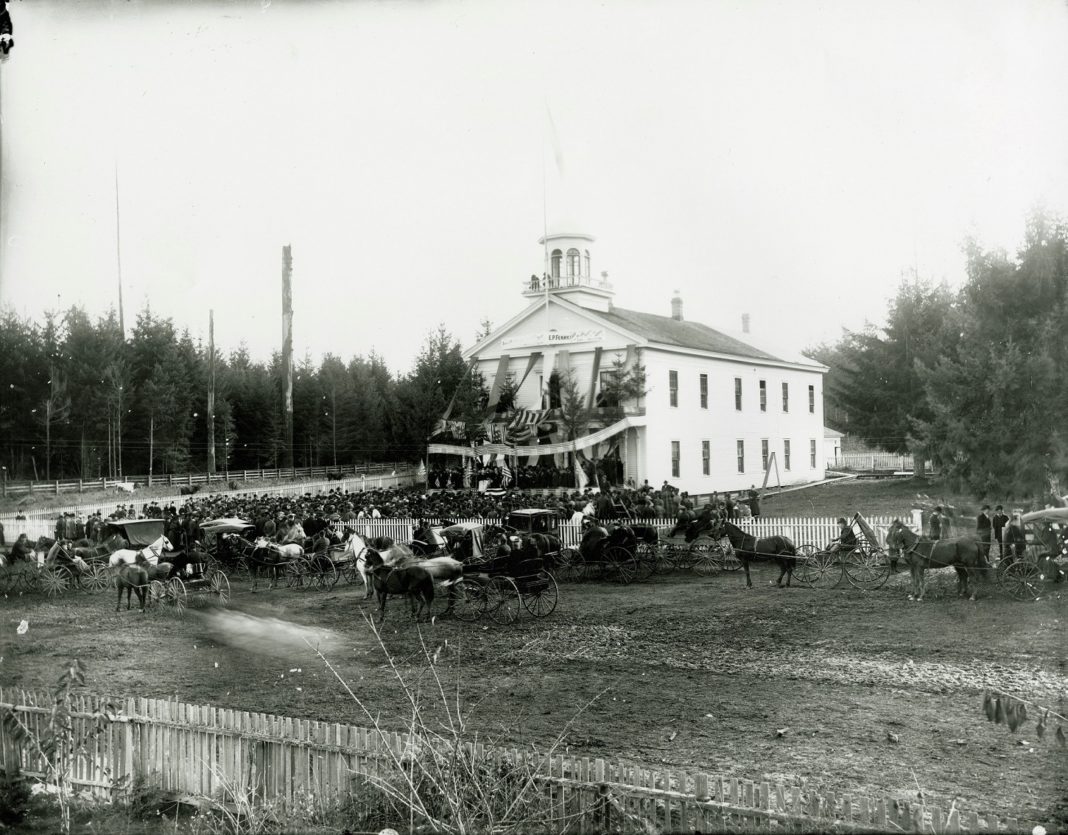Olympia is Washington State’s capital city. Nowadays, state offices are headquartered in Olympia, Tumwater and Lacey with branch offices throughout the entire state, but Legislature still meets in Olympia. It convenes in the beautiful, domed Legislative Building at the heart of the modern state Capitol Campus.
 But that was not true in the past. Indeed, the Legislature has met in different buildings in Olympia. Washington’s first purpose-built Capitol was a small wooden structure located at what is now the western side of the Capitol Campus. The old structure stood between what is now the Legislative Building and Insurance Building. It was torn down many years ago.
But that was not true in the past. Indeed, the Legislature has met in different buildings in Olympia. Washington’s first purpose-built Capitol was a small wooden structure located at what is now the western side of the Capitol Campus. The old structure stood between what is now the Legislative Building and Insurance Building. It was torn down many years ago.

Washington Territory was created in 1853 from the much larger Oregon Territory, with Olympia as its capital. Olympia was picked because it had the only customs house in the Puget Sound region, the first newspaper north of the Columbia River and the largest population in the area. The new Washington territorial legislature first met at the Parker and Coulter Store in 1854. They later met at the Olympia Masonic Temple.
While waiting to construct a suitable permanent Capitol, the territorial legislature decided to construct a temporary building with federal funds. Land for this structure was cleared at an area that was far removed from the contemporary commercial core. Legislators and others would later sometimes complain about the isolation.
Delayed by the Puget Sound Indian War, the wooden Capitol was completed in 1856. Measuring 40 by 60 feet, the simple two-storied framed building was intended to house the territorial legislature. The first floor held a hall for the House of Representatives and two small committee rooms. Upstairs held a hall for the Council (Senate), two committee rooms and a room for the Territorial Library. On top, a cupola added a decorative touch.

No “permanent” Capitol was built to replace the temporary structure in the next few decades and by 1874 the “temporary” building was falling apart. Secretary of Washington Territory Henry G. Struve wrote to the federal Secretary of the Interior, Columbus Delano, that most of the inside of the building had never been lathed, plastered or painted. Moreover, the Capitol’s wooden block foundation had rotted, sinking parts of the floor and twisting the whole structure out of shape. Lighting was only meagerly provided by a few tin scones nailed to the wall and the heat was unusable. The exterior had not been painted for 18 years and “presents a sad picture of melancholy dinginess.”
Congress appropriated more than $5,000 to repair the building. Repairs were completed by 1883, including fixing leaks in the cupola, reroofing the building and painting. The building was in much better shape to host the 1889 constitutional convention for the state. Washington formally became the 42nd state on November 11, 1889. Hundreds gathered at the Capitol on November 18 to celebrate the news and watch the inauguration of the state’s first governor, Elisha P. Ferry.
By the 1890s, the state wanted a newer, grander Capitol. A design contest was held and the foundation of a new building was even laid, but construction was halted due to financial depression. Thurston County was facing similar financial crisis and the state purchased the county’s new courthouse building to use as the Capitol. The last session at the old territorial Capitol was in 1901.

After meeting at the Farquhar Store in 1903, the Legislature moved to the new Capitol in 1905. The old territorial Capitol was left behind, despite decades of use. The State Board of Control put it up for demolition, but initially rejected all bids because the workers wanted to be paid for the job. A second round of bidding was won by W. J. Giggey and J. W. Relf of Olympia, who agreed to remove the building and take only the scrap lumber as payment. They razed the structure in 1911.
It was an ignoble end for an important building. On May 10, 1911, the Morning Olympian dismissed the loss arguing that “The old Capitol has little historic value aside from being the place in which the first legislature of Washington met, after the state was admitted to the Union…the building…is simply an old structure with little to make in [sic] even interesting.” A new Capitol Campus was built in the area, including the domed Legislative Building completed in 1927.
A marker placed on the side of the current Legislative Building honors the original wooden capitol building. However, this historic landmark, where many important events occurred, has been lost. Its story reminds us how important it is to preserve historic buildings that still exist, before it is too late.




















































